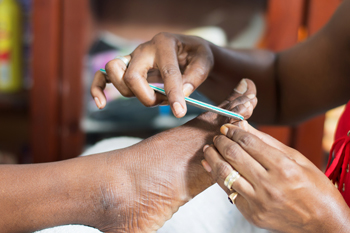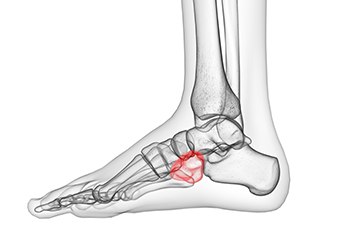

The feet carry the weight of the body and undergo extreme pressure during any given day. When everyday foot care is practiced, the feet can look and feel healthy, and there are simple methods that can accomplish this. It begins with washing and drying the feet daily, followed by applying a good moisturizer on them. It is a good practice to trim the nails weekly, and this is properly done by cutting them straight across instead of curved. Soaking the feet in warm water at the end of the day is not only relaxing for the overall body, but beneficial for the skin, which can become softer. It may make it easier to remove dead skin by using a pumice stone. It is suggested that shoes are the right size, and fit comfortably, as this may help to prevent unwanted corns, bunions, or hammertoes from developing. If you would like additional information about various foot care techniques to implement for better feeling feet, please consult with a podiatrist.
Everyday foot care is very important to prevent infection and other foot ailments. If you need your feet checked, contact Dr. Nooshin Zolfaghari from VIP Foot & Ankle Center. Our doctor can provide the care you need to keep you pain-free and on your feet.
Everyday Foot Care
Often, people take care of their bodies, face and hair more so than they do for their feet. But the feet are a very important aspect of our bodies, and one that we should pay more attention to. Without our feet, we would not be able to perform most daily tasks.
It is best to check your feet regularly to make sure there are no new bruises or cuts that you may not have noticed before. For dry feet, moisturizer can easily be a remedy and can be applied as often as necessary to the affected areas. Wearing shoes that fit well can also help you maintain good foot health, as well as making it easier to walk and do daily activities without the stress or pain of ill-fitting shoes, high heels, or even flip flops. Wearing clean socks with closed shoes is important to ensure that sweat and bacteria do not accumulate within the shoe. Clean socks help to prevent Athlete’s foot, fungi problems, bad odors, and can absorb sweat.
If you have any questions please feel free to contact our office located in Pembroke Pines, FL . We offer the newest diagnostic and treatment technologies for all your foot and ankle needs.

The feet endure an enormous amount of stress and wear during the day, and it is common for many people to experience some type of foot pain throughout their lives. Each foot has 26 bones, several tendons, muscles, and ligaments that work in harmony, providing mobility to complete daily activities. Any number of foot conditions can develop which may range from having toenail fungus to cutting the toenails improperly. Additionally, corns are a painful nuisance that generally develops on the side of the pinky toe, and can alter the gait to accommodate for the discomfort. These can come from shoes that do not fit correctly, and bunions can fall into the same category. A bunion is defined as a bony protrusion that develops on the side of the big toe, causing the other toes to shift toward each other. Any type of foot pain is treated by a podiatrist, and it is strongly advised that you contact this type of doctor who can offer you the correct relief options.
Foot Pain
Foot pain can be extremely painful and debilitating. If you have a foot pain, consult with Dr. Nooshin Zolfaghari from VIP Foot & Ankle Center. Our doctor will assess your condition and provide you with quality foot and ankle treatment.
Causes
Foot pain is a very broad condition that could be caused by one or more ailments. The most common include:
Diagnosis
To figure out the cause of foot pain, podiatrists utilize several different methods. This can range from simple visual inspections and sensation tests to X-rays and MRI scans. Prior medical history, family medical history, and any recent physical traumatic events will all be taken into consideration for a proper diagnosis.
Treatment
Treatment depends upon the cause of the foot pain. Whether it is resting, staying off the foot, or having surgery; podiatrists have a number of treatment options available for foot pain.
If you have any questions, please feel free to contact our office located in Pembroke Pines, FL . We offer the newest diagnostic and treatment technologies for all your foot care needs.

Sometimes when an individual breaks their foot or ankle, they might require some kind of surgical procedure. Depending on the procedure, the patient might not be able to put weight on their impacted foot or ankle following the surgery for a certain amount of time. Therefore, they might need the assistance of mobility devices to move around post-operation. Specifically, a medical professional might recommend that a patient use a pair of crutches after a foot surgery. These tools are significantly light in weight. Alternatively, for more serious surgical procedures, a medical professional might recommend using some kind of wheelchair during the recovery period of a surgical procedure. A knee walker is also an option for an individual who recently suffered a foot injury. It is also important to note that walking boots are smaller than any of the aforementioned mobility devices. The mobility device that you might use after a surgical procedure on your foot is largely dependent on the nature of the injury and procedure. Schedule an appointment with a podiatrist today for more information.
Foot surgery is sometimes necessary to treat a foot ailment. To learn more, contact Dr. Nooshin Zolfaghari of VIP Foot & Ankle Center. Our doctor will assist you with all of your foot and ankle needs.
When Is Surgery Necessary?
Foot and ankle surgery is generally reserved for cases in which less invasive, conservative procedures have failed to alleviate the problem. Some of the cases in which surgery may be necessary include:
What Types of Surgery Are There?
The type of surgery you receive will depend on the nature of the problem you have. Some of the possible surgeries include:
Benefits of Surgery
Although surgery is usually a last resort, it can provide more complete pain relief compared to non-surgical methods and may allow you to finally resume full activity.
Surgical techniques have also become increasingly sophisticated. Techniques like endoscopic surgery allow for smaller incisions and faster recovery times.
If you have any questions please feel free to contact our office located in Pembroke Pines, FL . We offer the newest diagnostic and treatment technologies for all your foot and ankle needs.

The cuboid bone is a short bone in the lateral or mid part of the foot. This bone acts as a pulley to a tendon in this part of the foot. When there is pain in this area, it is often from something called cuboid syndrome. This can occur from a disturbance with the articulation and joint involving this bone. Symptoms resemble ligament sprains, and pain can radiate into the foot. This syndrome is associated with other foot problems with this bone. Treatment can consist of manipulation of the cuboid bone, along with medial arch support. If you feel pain in this part of your foot, it is a good idea to consult with a podiatrist who can make a proper diagnosis and provide treatment options.
Cuboid syndrome, also known as cuboid subluxation, occurs when the joints and ligaments near the cuboid bone in the foot become torn. If you have cuboid syndrome, consult with Dr. Nooshin Zolfaghari from VIP Foot & Ankle Center. Our doctor will assess your condition and provide you with quality foot and ankle treatment.
Cuboid syndrome is a common cause of lateral foot pain, which is pain on the outside of the foot. The condition may happen suddenly due to an ankle sprain, or it may develop slowly overtime from repetitive tension through the bone and surrounding structures.
Causes
The most common causes of cuboid syndrome include:
Symptoms
A common symptom of cuboid syndrome is pain along the outside of the foot which can be felt in the ankle and toes. This pain may create walking difficulties and may cause those with the condition to walk with a limp.
Diagnosis
Diagnosis of cuboid syndrome is often difficult, and it is often misdiagnosed. X-rays, MRIs and CT scans often fail to properly show the cuboid subluxation. Although there isn’t a specific test used to diagnose cuboid syndrome, your podiatrist will usually check if pain is felt while pressing firmly on the cuboid bone of your foot.
Treatment
Just as the range of causes varies widely, so do treatments. Some more common treatments are ice therapy, rest, exercise, taping, and orthotics.
If you have any questions, please feel free to contact our office located in Pembroke Pines, FL . We offer the newest diagnostic and treatment technologies for all your foot care needs.